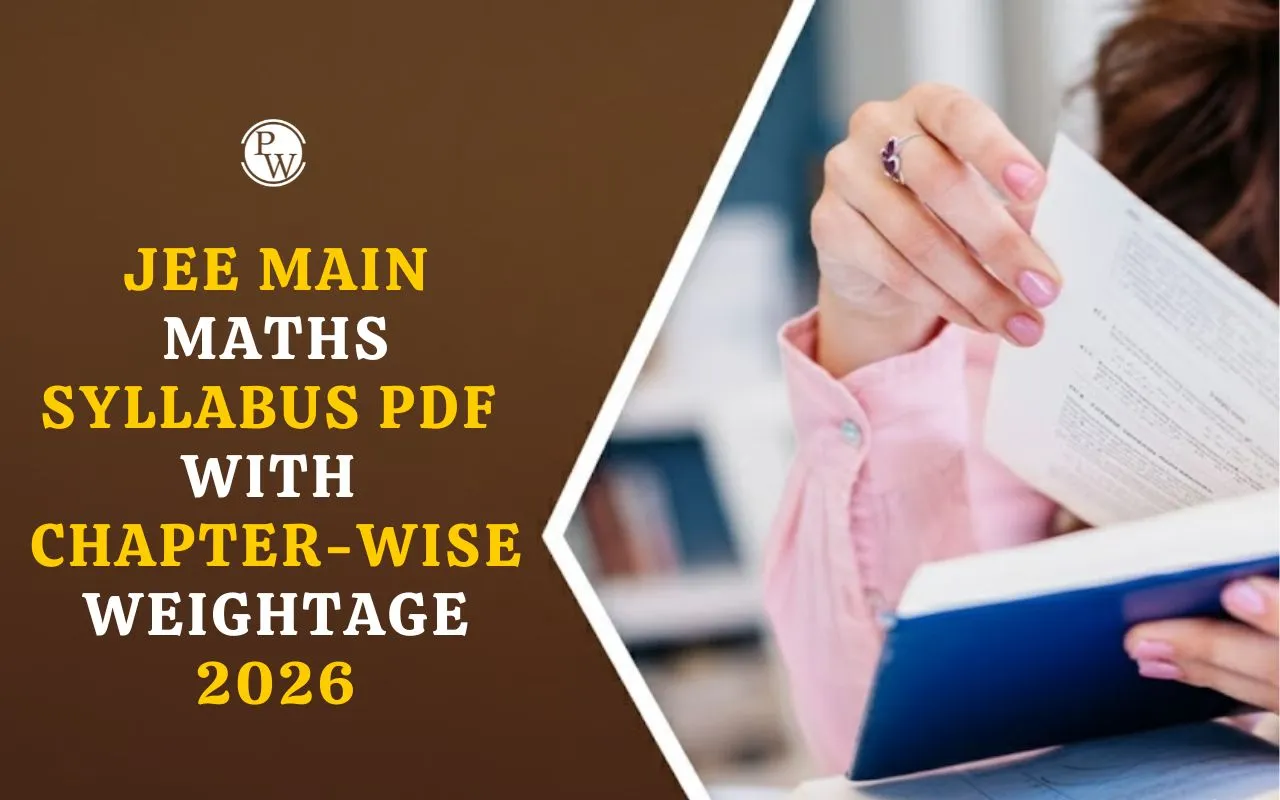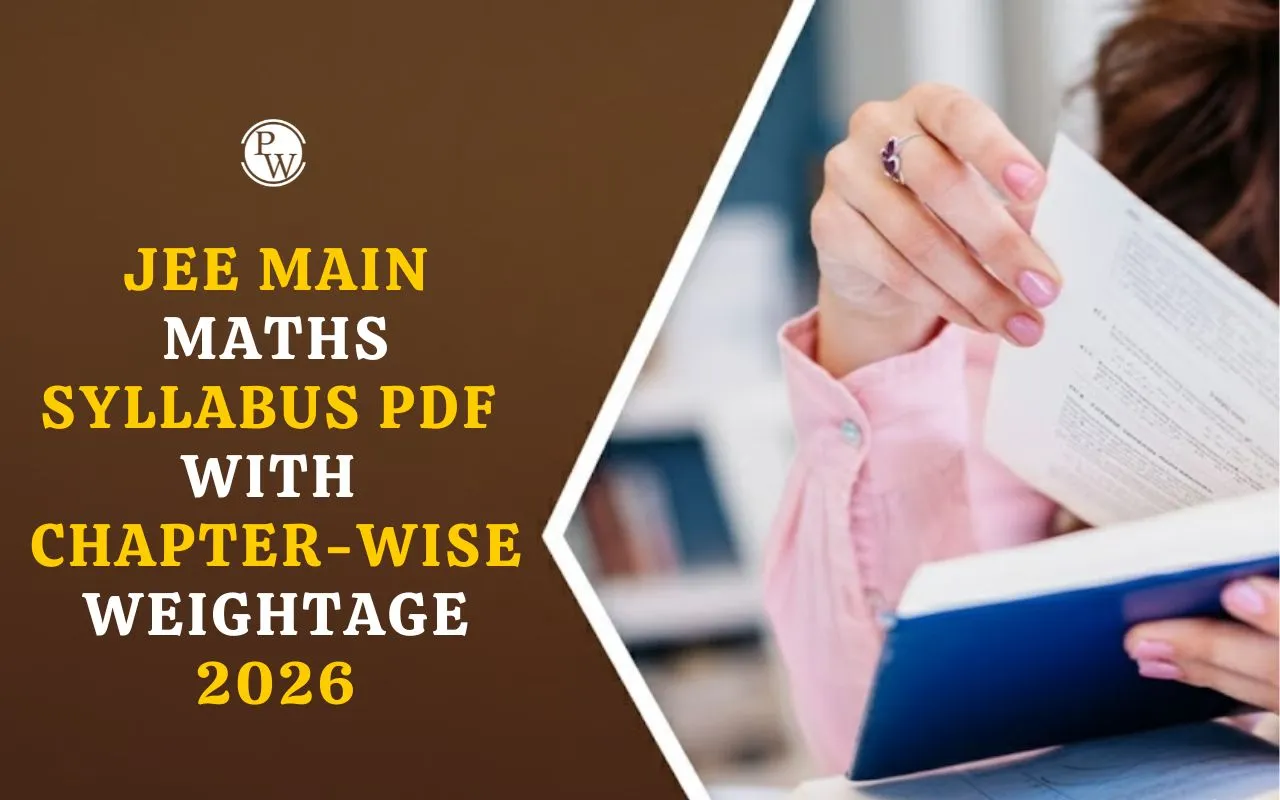

JEE Main Maths Syllabus PDF with Chapter-wise Weightage 2026: The JEE Main Maths Syllabus 2026 provides a comprehensive blend of Algebra, Calculus, Coordinate Geometry, Trigonometry, and Vector Algebra, helping aspirants develop both conceptual clarity and problem-solving efficiency. Mathematics plays a crucial role in boosting percentile, making it essential for students to understand the structure of the syllabus and identify high-weightage topics. Familiarity with chapter-wise trends enables smarter preparation and optimized revision. However, the official syllabus for JEE Main 2026 has not yet been released on the NTA website. Until then, students can rely on the previous year’s syllabus provided here to begin systematic and effective preparation.
Also Read: JEE Main Chapter-wise Weightage 2026 for Physics, Chemistry, Maths
JEE Main Mathematics Syllabus 2026
The JEE Main Mathematics Syllabus 2026 spans fundamental and advanced concepts across Algebra, Calculus, and Geometry. It tests analytical thinking, application skills, and strong reasoning. This syllabus remains largely consistent each year, making the previous year’s outline a reliable reference for preparation.
Sets, Relations and Functions
Sets and their representation; Union, intersection and complement of sets and their algebraic properties; Power set; Relations, type of relations, equivalence relations, functions; one-one, into and onto functions, the composition of functions.
Complex Numbers and Quadratic Equations
Complex numbers as ordered pairs of reals, Representation of complex numbers in the forma +iband their representation in a plane, Argand diagram, algebra of complex numbers, modulus and argument (or amplitude) of a complex number, Quadratic equations in real and complex number systems and their solutions; Relations between roots and coefficients, nature of roots, the formation of quadratic equations with given roots.
Matrices and Determinants
Matrices, algebra of matrices, type of matrices, determinants and matrices of order two and three, evaluation of determinants, area of triangles using determinants; Adjoint and inverse of a square matrix; Test of consistency and solution of simultaneous linear equations in two or three variables using matrices
Permutations and Combinations
The fundamental principle of counting, permutations and combinations; Meaning of P(n, r) and C(n, r). Simple applications.
Binomial Theorem and Its Simple Applications
Binomial theorem for a positive integral index, general term and middle term and simple applications.
Sequence and Series
Arithmetic and Geometric progressions, insertion of arithmetic, geometric means between two given numbers, Relation between A.M and G.M
Limit, Continuity and Differentiability
Real–valued functions, algebra of functions; polynomial, rational, trigonometric, logarithmic and exponential functions; inverse functions. Graphs of simple functions. Limits, continuity and differentiability. Differentiation of the sum, difference, product and quotient of two functions. Differentiation of trigonometric, inverse trigonometric, logarithmic, exponential, composite and implicit functions; derivatives of order upto two, Applications of derivatives: Rate of change of quantities, monotonic increasing and decreasing functions, Maxima and minima of functions of one variable.
Integral Calculus
Integral as an anti-derivative, Fundamental integrals involving algebraic, trigonometric, exponential and logarithmic functions. Integration by substitution, by parts and by partial fractions. Integration using trigonometric identities. Evaluation of simple integrals of the type
∫ dx / (x² + a²),
∫ dx / (x² ± a²),
∫ dx / (a² − x²),
∫ dx / √(a² − x²),
∫ dx / (ax² + bx + c),
∫ dx / √(ax² + bx + c),
∫ (px + q) dx / (ax² + bx + c),
∫ (px + q) dx / √(ax² + bx + c),
∫ √(a² ± x²) dx,
∫ √(x² − a²) dx
The fundamental theorem of calculus, properties of definite integrals. Evaluation of definite integrals, determining areas of the regions bounded by simple curves in standard forms.
Differential Equations
Ordinary differential equations, their order and degree, the solution of differential equation by the method of separation of variables, solution of a homogeneous and linear differential equation of the type
dy/dx + p(x)·y = q(x)
Coordinate Geometry
Cartesian system of rectangular coordinates in a plane, distance formula, sections formula, locus and situation, the slope of a line, parallel and perpendicular lines, intercepts of a line on the co-ordinate axis. Straight line: Various forms of equations of a line, intersection of lines, angles between two lines, conditions for concurrence of three lines, the distance of a point form a line, co-ordinate of the centroid, orthocentre and circumcentre of a triangle. Circle, conic sections: A standard form of equations of a circle, the general form of the equation of a circle, its radius and centre, equation of a circle when the endpoints of a diameter are given, points of intersection of a line and a circle with the centre at the origin and sections of conics, equations of conic sections(parabola, ellipse and hyperbola) in standard forms.
Three-Dimensional Geometry
Coordinates of a point in space, the distance between two points, section formula, direction ratios and direction cosines and the angle between two intersecting lines. Equation of a line; Skewlines, the shortest distance between them and its equation.
Vector Algebra
Vectors and scalars, the addition of vectors, components of a vector in two dimensions and three-dimensional spaces, scalar and vector products.
Statistics and Probability
Measures of dispersion; calculation of mean, median, mode of grouped and ungrouped data, calculationofstandard deviation, variance and mean deviation for grouped and ungrouped data. Probability: Probability of an event, addition and multiplication theorems of probability, Baye's theorem, probability distribution of a random variable.
Trigonometry
Trigonometrical identities and trigonometrical functions, inverse trigonometrical functions and their properties.
JEE Main Maths Syllabus PDF
Students can download the JEE Main Maths Syllabus PDF to access all chapters, subtopics, and expected question weightage in one place. The PDF helps in structured revision and tracking chapter-wise progress. Since the 2026 syllabus is not yet released, this compiled PDF based on previous years is ideal for early preparation.
JEE Main Maths Syllabus PDF: Click Here
JEE Chapter-wise Weightage Comparison for Maths
The tables below show the chapter-wise distribution of questions asked in the January and April sessions, helping you identify high-weightage areas for JEE Main 2026. Focus more on chapters that together make up over 50% of the paper, such as 3D Geometry, Matrices, Differential Equations, and the Binomial Theorem. Strengthening these topics can significantly boost your overall score.
|
Chapter Name |
Questions in JEE Main 2023 January Session |
Questions in JEE Main 2023 April Session |
|
Circle |
3 |
4 |
|
Inverse Trigonometric Functions |
7 |
4 |
|
Binomial Theorem |
11 |
13 |
|
Parabola |
10 |
3 |
|
Statistics |
4 |
5 |
|
Matrices and Determinants |
18 |
13 |
|
Limits of Functions |
10 |
9 |
|
Solutions of Triangles |
1 |
0 |
|
Trigonometric Ratios and Identities |
3 |
2 |
|
Quadratic Equations |
8 |
8 |
|
Differential Equations |
15 |
9 |
|
Sequence and Series |
13 |
13 |
|
Differentially & Method of Diff. |
2 |
2 |
|
Hyperbola |
5 |
7 |
|
Vector Algebra |
12 |
10 |
|
Complex Numbers |
8 |
8 |
|
Indefinite Integration |
5 |
3 |
|
Continuity |
2 |
2 |
|
Three-Dimensional Geometry |
18 |
17 |
|
Application of Derivatives |
4 |
9 |
|
Probability |
12 |
9 |
|
Basic Mathematics and Logarithms |
1 |
0 |
|
Trigonometric Equations |
2 |
5 |
|
Permutations and Combinations |
12 |
9 |
|
Definite Integration |
11 |
9 |
|
Functions |
10 |
11 |
|
Ellipse |
7 |
9 |
|
Set Theory and Relations |
11 |
13 |
|
Binomial Theorem |
11 |
13 |
JEE Main Maths Chapter-wise Weightage 2026 via Chart
Here’s the chapter-wise comparison chart for Maths (JEE Main 2023 January vs April sessions).
It shows how the number of questions varied between both sessions — for example:
-
Three-Dimensional Geometry and Matrices & Determinants had the highest weightage in both.
-
Some topics like Differential Equations and Parabola had fewer questions in April.
-
Sequence & Series, Set Theory, and Binomial Theorem remained consistent.
